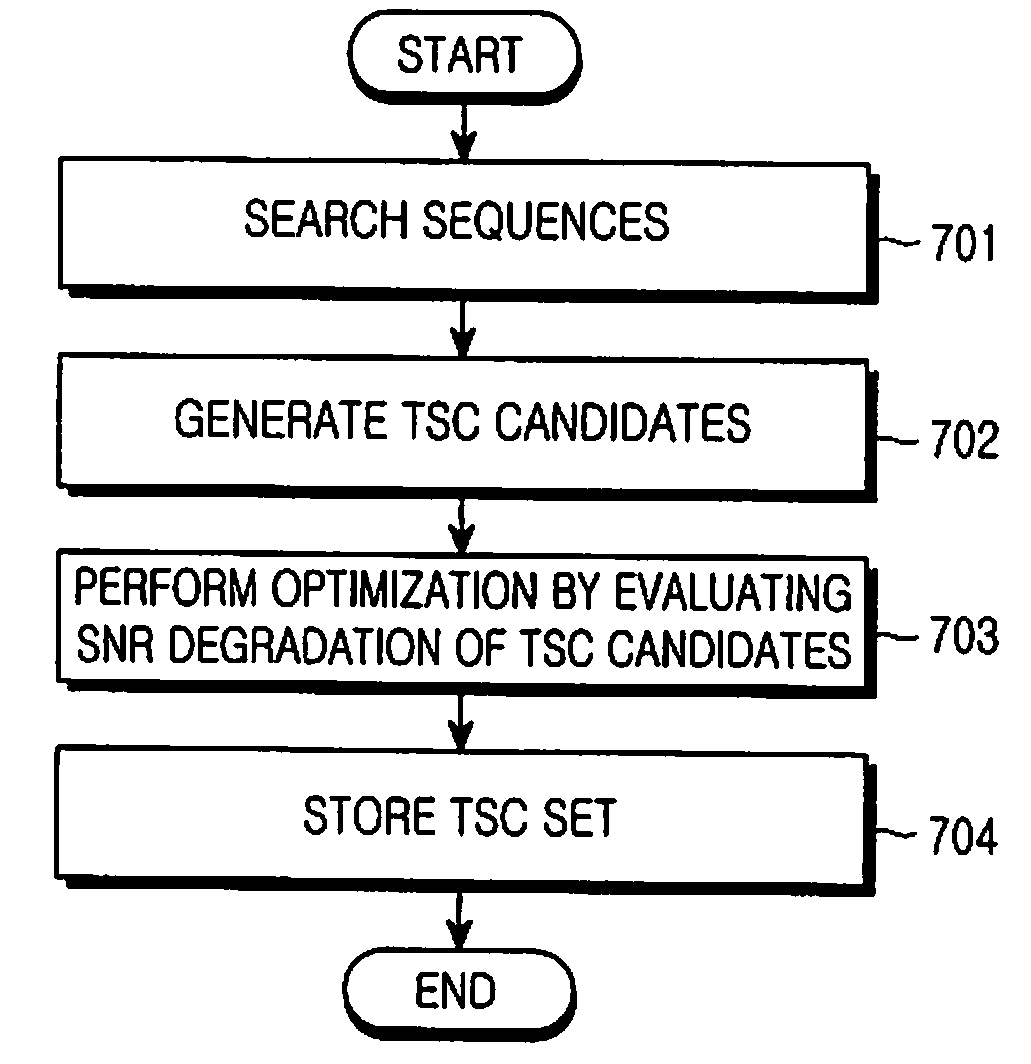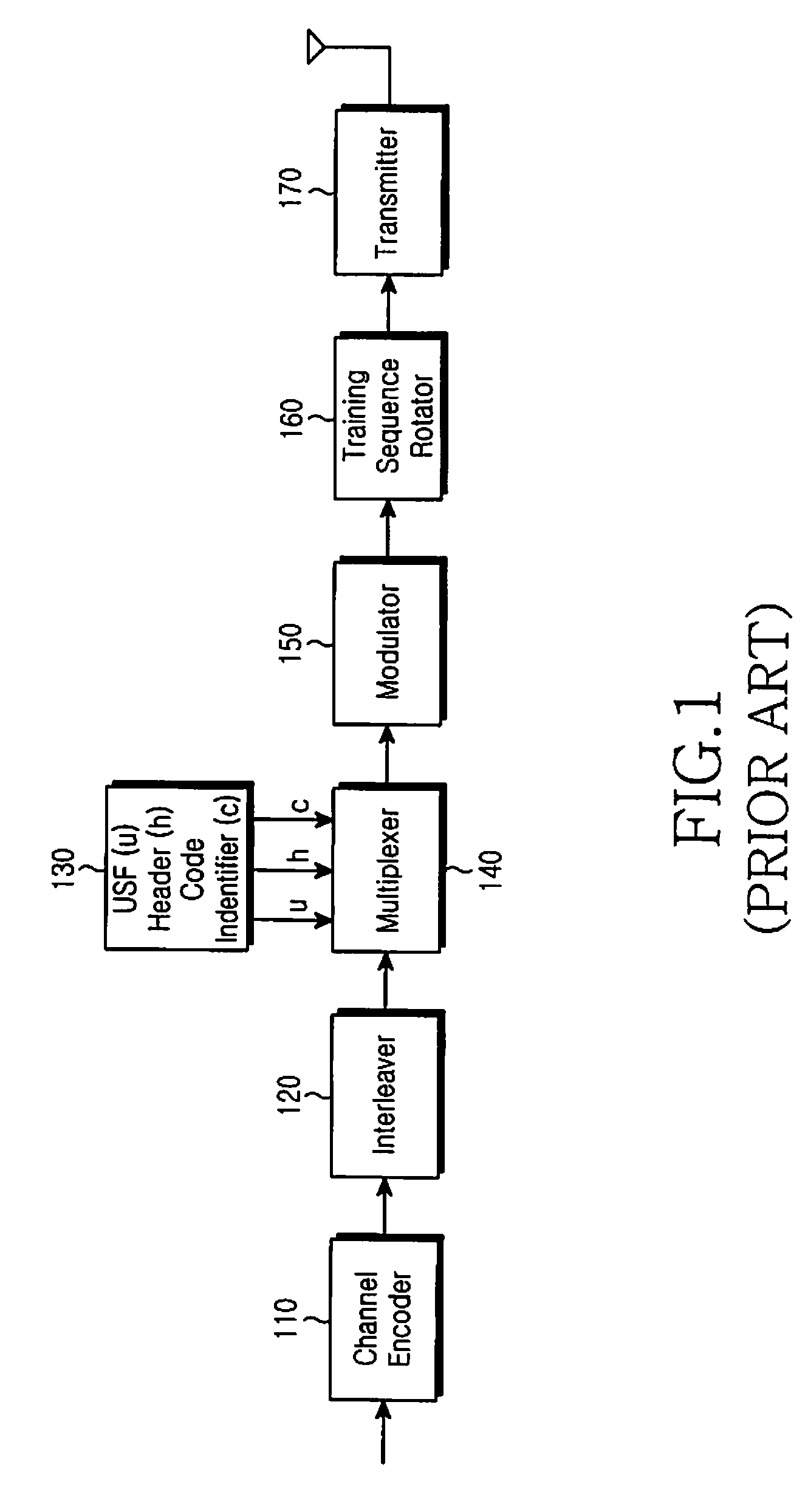Method and apparatus for generating training sequence codes in a communication system
a communication system and training sequence technology, applied in the field of method and apparatus for generating training sequence codes in the communication system, can solve the problems of system performance deterioration and system performance lowering, and achieve the effect of efficient transmission/receiving data
- Summary
- Abstract
- Description
- Claims
- Application Information
AI Technical Summary
Benefits of technology
Problems solved by technology
Method used
Image
Examples
embodiment 1
[0052]Step 1: All sequences corresponding to two sequences A and B that satisfy Equation (9) and have aperiodic autocorrelation properties are searched:
RA(k)+RB(k)=0, for k=±1, ±2, . . . , ±K (9)
RA(k)+RB(k)=2N, for k=0
[0053]In Equation (9), RA(k) denotes cross-correlation properties of the sequence A. Also, when TSCs, each having a length of 26 symbols, are considered in Equation (9), K and N are as follows: K=5, and N=8.
[0054]Step 2: TSC candidates with the structure illustrated in FIG. 4 are constructed by deriving sequences A′ and B′ from the sequences A and B.
[0055]If the two sequences A and B are Golay complementary sequences, the sequence A is in autocorrelation and complementary relationships with the sequence B. With respect to the autocorrelation, there is a property as given by Equation (10):
RA′A(k)+RB′B(k)=0, for k=±1, ±2, . . . , ±K (10)
RA′A(k)+RB′B(k)=2N, for k=0
[0056]Step 3: For the TSC candidates generated in step 2, SNR_d is optimized using the min-max optimizati...
embodiment 2
[0059]Step 1: All sequences corresponding to two sequences A and B that satisfy Equation (10) and have periodic autocorrelation properties are searched.
[0060]Step 2: TSC candidates with the structure illustrated in FIG. 4 are constructed by deriving sequences A′ and B′ from the sequences A and B.
[0061]Step 3: For the TSC candidates generated in step 2, SNR_d is optimized using the min-max optimization method disclosed in Korean Patent Application No. 10-2007-0012938 in order to find as many TSCs as necessary.
[0062]Step 4: The TSCs found in step 3 are stored.
[0063]FIG. 6 illustrates an example of a TSC set that is found according to the second embodiment for generating sequence pairs of the present invention. This TSC set is an example suitable for a normal burst in GSM / EDGE.
[0064]FIG. 7 illustrates a procedure of generating TSCs according to an exemplary embodiment of the present invention.
[0065]Referring to FIG. 7, in step 701, sequences are searched. Sequences A and B that have ap...
embodiment 3
[0070]In the third embodiment for generating sequence pairs of the present invention, TSCs that each have a length of 30 symbols are generated.
[0071]The length of each TSC is determined by N′=2N+10, and is 30 symbols when N=10. Assuming that x is a TSC sequence with a length of 30 symbols, x is represented by Equation (11):
x=(x0,…,x29)=(a5,…,a9,A′a0,…,a5,…,a9,Ab5,…,b9B′,b0,…,b5,…,b9B)(11)
[0072]In Equation (11), A′ and B′ as well as A and B can be generated according to the first or second embodiment of the present invention.
[0073]Binary TSCs generated as described above, each having a length of 30 symbols, correspond to TSC#0 to TSC#7 from each of which the first bit is excluded.
PUM
 Login to View More
Login to View More Abstract
Description
Claims
Application Information
 Login to View More
Login to View More - R&D
- Intellectual Property
- Life Sciences
- Materials
- Tech Scout
- Unparalleled Data Quality
- Higher Quality Content
- 60% Fewer Hallucinations
Browse by: Latest US Patents, China's latest patents, Technical Efficacy Thesaurus, Application Domain, Technology Topic, Popular Technical Reports.
© 2025 PatSnap. All rights reserved.Legal|Privacy policy|Modern Slavery Act Transparency Statement|Sitemap|About US| Contact US: help@patsnap.com



